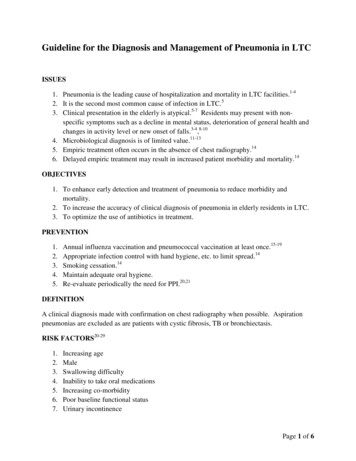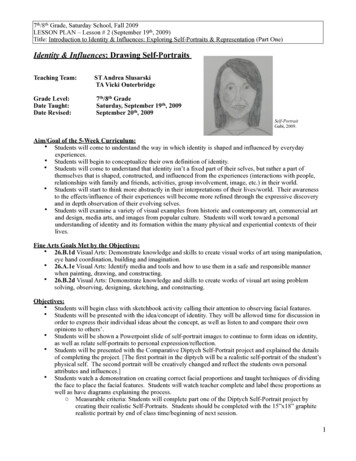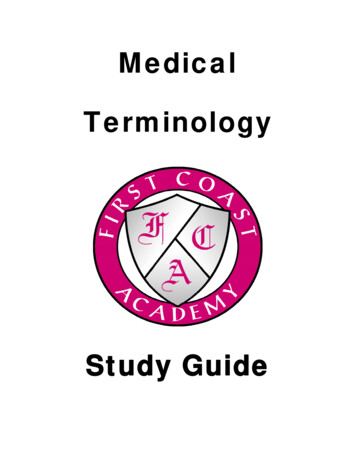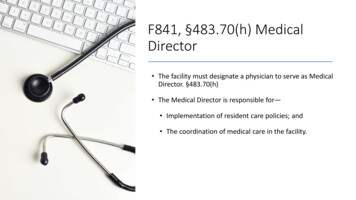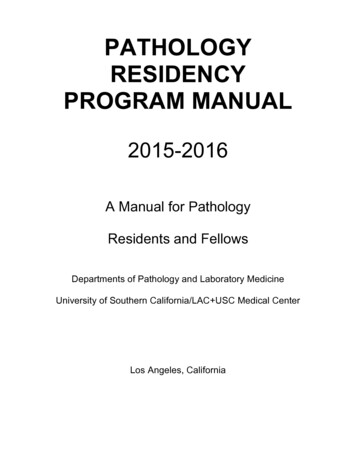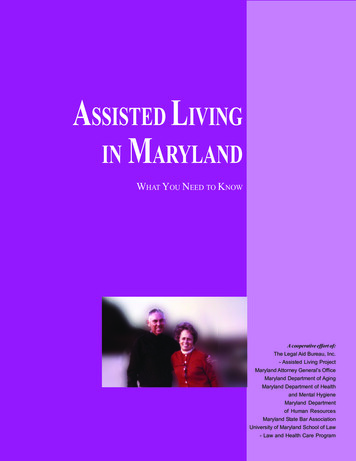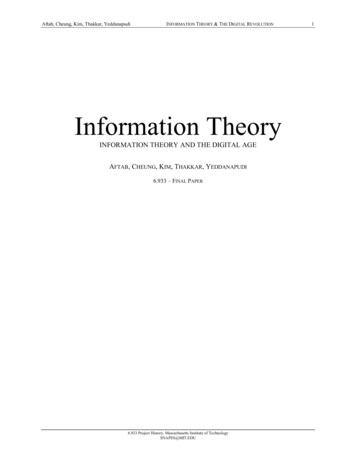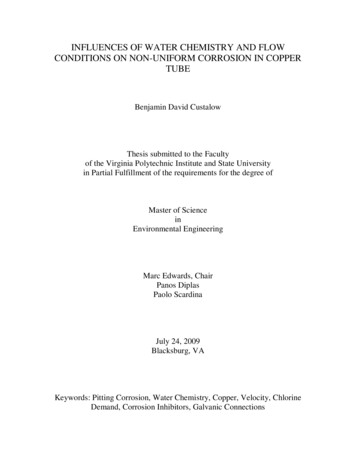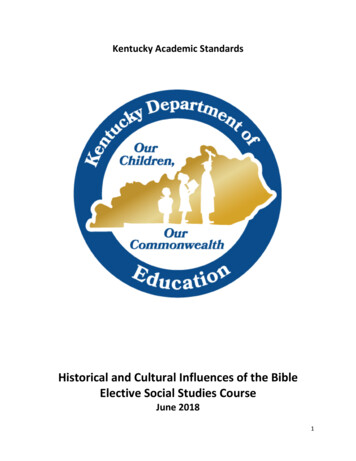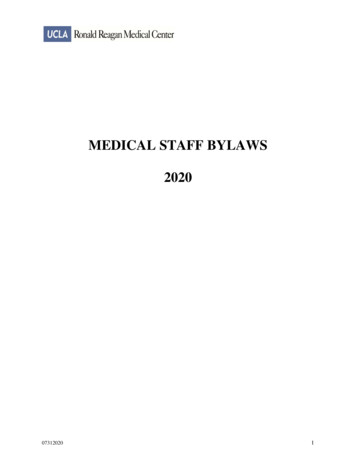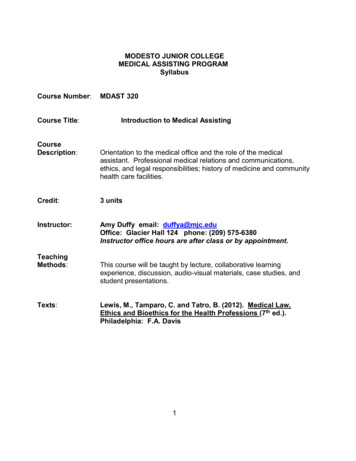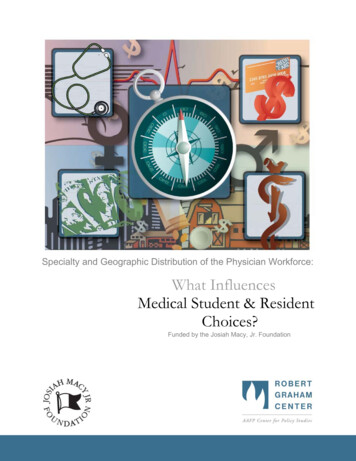
Transcription
Specialty and Geographic Distribution of the Physician Workforce:What InfluencesMedical Student & ResidentChoices?Funded by the Josiah Macy, Jr. Foundation
Specialty and Geographic Distribution of the Physician Workforce:What Influences Medical Student and Resident Choices?The Robert Graham Center: Policy Studies in Family Medicine and Primary CareRobert L. Phillips, Jr., MD MSPHMartey S. Dodoo, PhDStephen Petterson, PhDImam Xierali, PhDAndrew Bazemore, MD MPHBridget Teevan, MSKeisa Bennett, MDCindy Legagneur, BSJoAnn Rudd, MAandJulie Phillips, MD MPHMichigan State University College of Human MedicineMarch 2, 2009Copyright 2009Josiah Macy, Jr. Foundation Grant B07-09Approved by the Georgetown University IRB
Specialty and Geographic Distribution of the Physician Workforce:What InfluencesMedical Student & ResidentChoices?The Robert Graham CenterWashington, DCWith Support From:The Josiah Macy, Jr. Foundation
ii
CollaboratorsAdvisory BoardCandice Chen, MD MPHGeorge Washington UniversityMedical Education Futures StudyGeorge E. Fryer, Jr., PhDUniversity of Arkansas for Medical SciencesDiane R. Rittenhouse, MD MPHUniversity of California San FranciscoScott Shipman, MD MPHDartmouth Medical Collegeiii
AcknowledgementsWe thank the following for their generous help with Study Data and Recommendations:David C. Goodman, MD MSDartmouth Medical CollegeSarah Brotherton, PhDAmerican Medical AssociationBob EdsallAmerican Academy of Family Physiciansiv
Table of ContentsAbout The Robert Graham Center . . . .viExecutive Summary . . .viiForeword . .xiMessage from the Josiah Macy, Jr. Foundation .xiiiFigures. . . .xvChapter OneWhat We Know About Factors Affecting Medical Student & Resident Career Decisions.1Chapter TwoStudy Aims, Questions, Methods, Limitations.8Chapter ThreeOutcomes of Current Physician Training.13Chapter FourDebt.16Chapter FiveTitle VII Effect, Personal Interests, and Experiences in Medical School.33Chapter SixReturn on Investment . 40Chapter SevenConclusions and Recommendations . . 45Appendices . . . 53References . . . . . 75v
About The Robert Graham CenterThe Robert Graham Center:Policy Studies in Family Medicine and Primary CareThe Robert Graham Center is a research center that exists to improve individual and population healthby enhancing the delivery of primary care. The Center aims to achieve this mission through thegeneration or synthesis of evidence that brings a family medicine and primary care perspective to healthpolicy deliberations from the local to international levels. It is a functioning division of the AmericanAcademy of Family Physicians that operates with editorial independence.This project was completed with the support of the Josiah Macy, Jr. Foundation.The information and opinions contained in research from the Graham Center do not necessarily reflectthe views or policy of the AAFP.vi
Executive SummaryUnlike many Western nations, the United States does not manage or actively regulate the number, type,or geographic distribution of its physician workforce. As a result, medical trainees choose how and whereto work. As with most free markets, equitable distribution is at risk without well-informed, evidence-basedpolicies and incentives capable of promoting equitable access to appropriate care. This study contributesto understanding of important policy options and incentives by identifying factors that influence medicalstudent and resident choices about medical specialties and location of practice. Specifically, it identifiesfactors that are associated with choice of primary care specialties, particularly family medicine, and withcaring for rural and underserved populations.Prior studies of the impact of debt on student specialty choice have revealed mixed effects. Recentstudies suggest that physician payment disparities and the medical school learning environment arepotent factors for specialty choice, and that exposure to Federal Title VII grant-funded programs duringmedical school and residency is associated with higher likelihood of students choosing primary carespecialties and practice in underserved settings. Most studies of specialty choice or practice locationfocus on the decisions students make at graduation or immediately thereafter. This study is perhaps themost comprehensive to date, as it examines multiple factors along the training path and how they relateto the end result, which is specialty of physician practice and where they practice.This study incorporates nearly 20 years worth of survey data from graduating medical students abouttheir experiences, their debt, their beliefs, and their intentions. It includes historical files over the sameperiod of exposure to Title VII funds during training, and of participation in National Health Service Corps(NHSC). It includes cross-sectional data about physicians' current specialties and practice locations, anda five-year cross-section of service in Rural and Federally Qualified Health Centers. All of these dataabout individual physicians were brought together to test for associations between student characteristicsand training influences that may have policy relevance for a more purposefully produced health careworkforce.Findings:The income gap between primary care and subspecialists has an impressively negative impact on choiceof primary care specialties and of practicing in rural or underserved settings. At the high end of the range,radiologist and orthopedic surgeon incomes are nearly three times that of a primary care physician. Overvii
a 35-40 year career, this payment disparity produces a 3.5 million gap in return on investment betweenprimary care physicians and the midpoint of income for subspecialist physicians.There are measurable student characteristics, intentions, and training experiences that are significantpredictors of our study outcomes. Rural birth, interest in serving underserved or minority populations,exposure to Title VII in medical school, and rural or inner-city training experiences all significantlyincreased the likelihood of students choosing primary care, rural and underserved careers. Being marriedincreased the likelihood of choosing family medicine. Attending a public medical school significantlyincreased the probability of choosing a primary care specialty and practicing in a rural, shortage orunderserved area, compared with private medical schools. Title VII exposure in residency increased thelikelihood of serving in the National Health Service Corps and physician shortage areas but not primarycare or rural practice. Other student characteristics reduced the likelihood of study outcomes. Women aremuch less likely to choose rural practice, and men are less likely to choose primary care.The outcomes associated with debt were complex. Students with no debt and no obligating scholarships(NHSC or Armed Forces) were the least likely to later practice in primary care, in a rural area or in ahealth center. Debt above 250,000 also reduced these outcomes compared to other levels of debt.Students who took scholarships and reduced debt were much more likely to have careers in all three.There is a group of students sensitive to debt or agreeable to trading debt for service that chooses NHSCand, possibly, other loan repayment programs. The NHSC is currently only available to 3-4% ofphysicians despite a much larger applicant pool.Conclusions:The outcomes we studied -- practicing in primary care, practicing in family medicine, practicing in a ruralcommunity, practicing in a health center, practicing in an underserved area, ever having served in theNHSC-- are important if we hope to secure access to primary care for all people in the United States.Within the last decade, US medical student interest in and choice of these important outcomes fell wellbelow the thresholds necessary to maintain the physician workforce in primary care and underservedsettings, threatening to enhance an existing workforce maldistribution.The complex relationship between debt and career outcomes likely has several explanations. Medicalstudents increasingly come from affluent families who may influence career specialty and incomeexpectations, and limited exposure to rural or underserved populations. Alternatively, debt-aversestudents may not apply to medical school due to fear of debt or may choose less expensive publicschools. Both suggest a selection bias against our study outcomes--schools may select students lesslikely to choose these careers, or students more likely to make these choices are not applying. Studentswilling to accept obligating debt reduction (NHSC, military), are much more likely to later practice andviii
remain in primary care and underserved settings and such programs could be an option for morestudents and residents.This study reaffirms the positive relationship between Title VII exposure and most of our study outcomesdespite severe reductions in Title VII funding. It is an important support for the presence and quality ofstudent training experiences and is an immediately relevant policy option that promotes these outcomesas it is currently due for reauthorization.Growing physician income disparities are a major driver of student behavior. It does so directly, but alsoindirectly through messages about prestige, intellectual rigor, need to increase “productivity,” and status.In many academic health centers, primary care is labeled as the revenue “loss leader” rather than as acore function or even producer of downstream revenue. This income disparity explains much of thedifficulty in achieving the balance in specialty and geographic physician distribution and will continue toinhibit achieving the workforce needed for better quality, efficiency and equity.These potent effects of market factors do not absolve medical schools and residency programs of theirrole in affecting student choices. We found clear evidence that the student selection process andcurriculum are very important in producing primary care physicians and physicians willing to serve in ruraland underserved settings. In general, public and rural schools do a better job of producing primary care,rural and health center physicians, which should be an important consideration in the ongoing expansionof medical school capacity and in the design of new schools. They should also be a focus for state andfederal funding of programs that enhance their success with these outcomes.Feminization of primary care, particularly pediatrics and family medicine, threatens the rural workforcewithout efforts to make rural practice a more attractive or viable choice for women. We also need tounderstand male resistance to primary care careers and how to improve it as an option.Finally, there is a convergence of interest in assuring sustaining healing relationships through primarycare among large employers and federal advisory bodies and agencies. Previously unthinkableconversations are happening about investing more in primary care and in specific models of care that canunfetter primary care’s capacity to achieve the effectiveness, efficiency and equity realized in othercountries. There are also calls for changes in how training is financed and the settings in which trainingcan be supported to purposefully align training with desirable population health outcomes. Both policyefforts—enhancement of primary care functions and accountable training of the next generation ofphysicians—will be needed to reverse the current trends for more expensive and less equitable healthcare. We believe that this study offers supporting evidence for these policy efforts and suggests ways thatthe training pipeline can be modified to help.ix
Recommendations:1. Create more opportunities for students and young physicians to trade debt for service,through effective programs such as the National Health Service Corps.2. Reduce or resolve disparities in physician income.3. Admit a greater proportion of students to medical school who are more likely to chooseprimary care, rural practice, and care of the underserved.4. Study the degree to which educational debt prevents middle class and poor students fromapplying to medical school and potential policies to reduce such barriers.5. Shift substantially more training of medical students and residents to community, rural andunderserved settings.6. Support primary care departments and residency programs and their roles in teaching andmentoring trainees.7. Reauthorize and revitalize funding through Title VII, Section 747 of the Public Health ServiceAct.8. Study how to make rural areas more likely practice options, especially for women physicians.9. New medical schools should be public with preference for rural locations.x
ForewordThe United States struggles with an enduring shortage of physicians in rural and underserved areas, andwith reliable production of primary care physicians. There is growing concern that these problems willgrow worse as fewer graduates of US medical schools choose primary care, as student economicdiversity declines in medical schools, and as fewer international graduates come to the US on visas thatobligate them to work in underserved areas. Physician maldistribution, by specialty and geography,results in gaps in access to care, gaps that result in health disparities suffered by specific regions, races,and income groups. Sizeable growth of the physician workforce in the last two decades has not resolvedthe maldistribution, and current efforts to simply train more physicians are unlikely to help. Market forcesalone will not prepare our nation to care for the BabyBoom generation or expand the health care safety net toa growing un- and underinsured population.In 2008, the World Health Organization World HealthReport called for a return to primary health care, notingWhen countries at the samelevel of economic developmentare compared, those wherethat when countries at the same level of economichealthcareisorganizeddevelopment are compared, those where health care isaround the tenets of primaryorganized around the tenets of primary health carehealth care produce a higherproduce a higher level of heath for the samelevel of health for the sameinvestment.(1) The report notes that, “health care isinvestment.(1)often delivered according to a model that concentrateson diseases, high technology, and specialist care, withhealth viewed as a product of biomedical interventions and the power of prevention largely ignored. Theresults are predictable: unnecessary tests and procedures, more frequent and longer hospital stays,higher overall costs, and exclusion of people who cannot pay.”(2)Even as States demonstrate a willingness to fund expansion of physician training there is remarkably littledirection or funding to purposefully tailor the output to future needs. Meanwhile, the miniscule but criticalFederal funding designed to affect physician distribution is in real jeopardy: Title VII funding is reduced toa trickle after the program suffered from inadequate evaluation; Medicare Physician Scarcity Area bonuspayments sunset without evaluation or attention; and, Health Professional Shortage Area incentivepayments were threatened by a redesignation proposal that was not coordinated with Medicare. Thefederal government purposefully doubled the capacity of the healthcare safety net over the past decade,xi
but failed to coordinate a physician training effort to staff further expansion. Policy makers couldpurposefully couple these very expensive efforts--physician production and improving health care access-but need evidence to guide the use of scant resources to good effect.Like the Macy Foundation, the Robert Graham Center is committed to finding evidence-based policyoptions for healthcare workforce improvement and the related goal of securing access to care for allAmericans. This is our first collaboration with the Macy Foundation and we are most grateful for theirsupport of our research.xii
Message from the Josiah Macy, Jr. FoundationThere is once again a serious discussion about extending health care to all Americans, and there is thereal possibility that this time it is going to happen. In this context, the question about whether there will beenough primary care physicians, in the right locations, to serve the needs of the public takes on a greaterurgency. With a declining number of medical graduates choosing careers in primary care or willing topractice in underserved areas, it is important to understand the factors that increase or decrease thelikelihood of students and residents choosing such career paths. This understanding can then be thebasis for interventions that might influence these outcomes in a socially desirable way.The Josiah Macy, Jr. Foundation is pleased to have funded this study by the Robert Graham Center. It isone of the most comprehensive assessments of the influences on medical student and resident careerchoice. It incorporates nearly 20 years of survey data and looks at the final outcomes of type and locationof practice rather than the proximate outcomes of residency choices.The results indicate that the determinants of career choice are complex and multifactorial. It is clear thatthe large and increasing income gap between primary care and specialty care has a negative impact onthe decision to enter primary care or to practice in an underserved area. This is not surprising, but thefindings from this study should give further impetus to policy and payment changes that would narrow thisgap.Beyond this, one of the most important findings of this study is that the content and milieu of the medicalschool experience do matter in career choice. Medical educators sometimes have taken a fatalistic viewthat they cannot influence these choices because they are solely driven by market forces. But this studyclearly shows that the nature of clinical experiences in medical school and residency as well as thelearning environment itself can have a positive impact on the likelihood of choosing careers in primarycare. It is also clear from this study, even with its limitations in the amount of socioeconomic dataavailable, that the characteristics of the students upon admission are important determinants as well.Both of these findings are important messages to medical school leaders to encourage innovations inadmissions policies and curriculum at this time of medical school expansion.The role of student debt in the decision making process is extremely complex. In this study, as in severalother studies, it has failed to emerge as a dominant factor. I suspect this is because it is powerfullyxiii
confounded by the overlap between the student characteristics that predict debt or freedom from debt andthose that predict the likelihood of primary care or specialty care as a career choice. Students most likelyto incur high debt are also those most predisposed to go into primary care or to practice underservedareas; and those from the highest socioeconomic strata who are most likely to be debt-free are also mostlikely to be interested in specialty care and in practice sites that afford them a similar lifestyle to that inwhich they were raised. That said, we have no reliable way to assess who never enters the professionbecause of prospective debt or the full extent of the negative influence of debt among the subset ofstudents most predisposed to careers in primary care. Targeted programs to address these issues wouldbe highly desirable, and expanded programs to allow recent graduates to reduce debt by providing publicservices would make good policy sense.This document should serve as an important input to health care reform discussions in the new Obamaadministration, in Congress and in wider health policy circles. I applaud Robert Phillips and his team atthe Graham Center for their excellent work.George E. Thibault, MDPresidentJosiah Macy, Jr. Foundationxiv
FiguresReportTable 1:Physician specialty, practice location and NHSC service.15Table 2:Debt among graduating medical students who have debt and practice location(deflated with the CPI, 1979-2001).18Table 3:Relative risk of medical school primary care experience and career aspirationsfor specialty outcome.38Table 4:Average years of exposure and estimated annual average costs of medicaleducation and physician earnings.43Table 5:Estimated total cost of medical education, physician earnings and the returns toinvestment in medical education.44Figure 1:Mean debt among graduating medical students who have debt in public and privateschools (adjusted with the Consumer Price Index).18Figure 2: Relative likelihood of choosing a primary care career . .22Figure 3: Relative likelihood of choosing a family medicine career.23Figure 4: Relative likelihood of serving in the National Health Service Corps.24Figure 5: Relative likelihood of practice in a Federally Qualified or Rural Health Center.25Figure 6: Relative likelihood of practice in a rural area.26Figure 7: Relative likelihood of practice in a shortage area or underserved area.27Figure 8:Relative likelihood of association between various outcomes and exposureto Title VII Funding.28Figure 9a: Title VII exposure, debt and obligating scholarships in relation to selected outcomes:Choice of primary care specialty.29Figure 9b: Title VII exposure, debt and obligating scholarships in relation to selected outcomes:Practice type.30Figure 9c: Title VII exposure, debt and obligating scholarships in relation to selected outcomes:Practice location.31Figure 10: Progress of the physician payment gap.32Figure 11: Relative likelihood of association between various medical school experiencesand exposure to programs funded by Title VII.37AppendixTable A1: Creation of analysis data file and data management . 57xv
Table A2: Distribution of physicians by specialty and analysis group (2001-2005) .59Table A3: Distribution of sites, providers and beneficiaries with Medicare claims (2001-2005). 59Table A4: Distribution of GQ survey respondents -- from 1992 . 60Table A5: Mean and median debt among graduating medical students in public schoolswho have debt (deflated with the CPI) . 60Table A6: Mean and median debt among graduating medical students in private schoolswho have debt (deflated with the CPI) .61Table A7: Distribution of graduating medical students by whether they received medical schoolscholarships . .62Table A8: Basic statistics from the analysis file .62Table B1: Response variable: Chose primary care career. . 65Table B2: Response variable: Chose family medicine (FP/GP) career . . .66Table B3: Response variable: Ever provided NHSC service .67Table B4: Response variable: Ever provided service in FQHC or RHC. . 68Table B5: Response variable: Ever practice in rural area.69Table B6: Response variable: Ever practiced in a shortage area or underserved area.70Table C1: List of analysis variables . .71Figure 1: Flow diagram showing match-merge results . 58xvi
Chapter OneWhat We Know About Factors Affecting Medical Student & Resident CareerDecisionsMedical schools and residency training programs in the United States produce fewer primary carephysicians than subspecialist physicians, and have done so for decades.(3) The popularity of primarycare among US medical students has been steadily declining for the last decade, and is now at historiclows.(4) This is especially true for Family Medicine, the broadest primary care field, and the one in whichresidents are least likely to eventually subspecialize and most likely to care for underservedpopulations.(5) The imbalance of primary care tospecialist physicians in the U.S. physicianIt is critical for our nation’s futurehealth to understand why mostU.S.medicalstudentsarecareers or service to the nation’sneedypopulations,costs(3;6;7) and leaves many parts of the countrywithout primary care physician access, especiallynotchoosing to practice primary caremostworkforce contributes to high health careandrural and low-income urban areas. In the comingdecades, some have projected a substantialphysician shortage in the United States,(8)including primary care physicians.(9) While thesewhere state, federal, and privateprojections are debatable, two things arefunding sources can best be usedbecoming more clear: 1) There is a problem withto address these shortfalls.sufficient access to primary care physicians in ruraland impoverished areas(3); and 2) current practiceconfiguration or organization will have greatdifficulty absorbing all uninsured patients if universal access is achieved.(10) Now more than ever, it iscritical for our nation’s future health to understand why most U.S. medical students are not choosing topractice primary care careers or service to the nation’s most needy populations, and where state, federal,and private funding sources can best be used to address these shortfalls.Medical students’ career decision-making has been discussed and studied extensively. Studies haveshown that students’ choices of primary care or specialty careers are influenced by student-relatedfactors, such as gender, race and ethnicity, socioeconomic status, rural or urban background, andattitudes and values (11;12) ; and curriculum factors, particularly exposure to required Family Medicinecurriculum during the third or fourth year of medical school.(11-14) Debt studies are mixed but Specialtyincome difference has been a consistent factor in student specialty choice out of school. Specialty choice1
is also related to institutional factors, such as state funding, Title VII funding, and the strength of FamilyMedicine departments, which all contribute to the “institutional culture.”(13;13;15-19)Studies of student and physician decisions to practice in underserved areas are less extensive, but haveuncovered important predictors. Students who grow up in rural areas, plan to choose family medicine atmatriculation to medical school, and are male, have historically been more likely to practice rural primarycare.(20-24) Similarly, students who grow up in urban underserved areas are more likely to practice ininner cities.(20) Under-represented minority physicians(25;26) and women(26) are more likely to care forunderserved populations. Personal values, spirituality, and mentoring also increase students’ likelihoodof choosing service careers.(25-27) Finally, longitudinal, comprehensive medical school and residencyeducational programs with the explicit goals of preparation of students and physicians for underservedpractice have demonstrated clear success.(28-33)Despite the importance of these issues, and the understanding gained from previous researchers,significant gaps in knowledge remain about the role of medical student debt, scholarship and loanprograms, type of school, curriculum, institutional culture, and potential income on medical students’specialty choices and decisions to care for underserved populations.Medical Student DebtThe role of medical student debt in specialty choice has received significant attention, but is most oftenexamined through attitudinal surveys of students still in the process of training. Most medical studentscarry a debt burden on graduation that is out of proportion to that of other professions, and there is asubstantial income gap between primary care and speciali
Mar 02, 2009 · The outcomes we studied -- practicing in primary care, practicing in family medicine, practicing in a rural community, practicing in a health center, practicing in an underserved area, ever having served in the NHSC-- are important if we hope to secure ac
